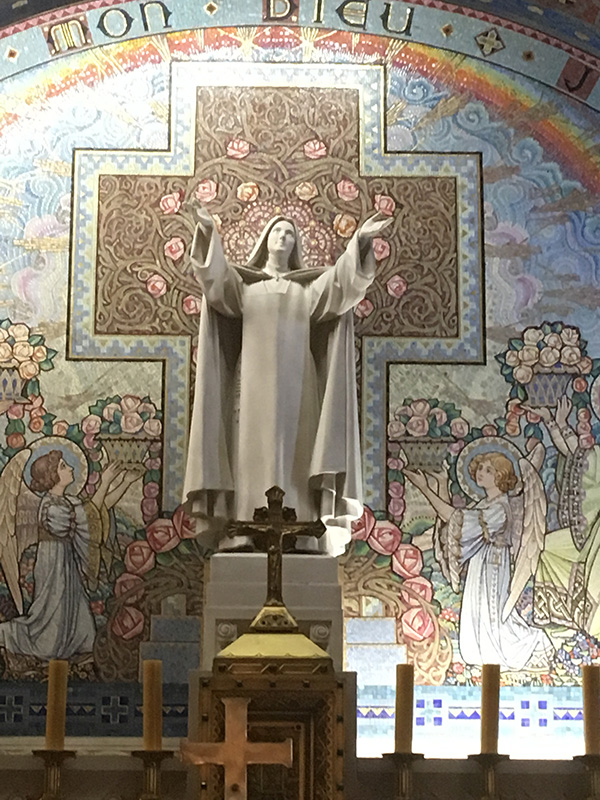
WINDSOR TERRACE — The Little Flower has a big influence.
St. Therese of Lisieux, known as “The Little Flower,” is one of only four female saints with the title “Doctor of the Church,” an honor that has been bestowed on fewer than 40 saints throughout history and signifies their importance as teachers of the faith whose lessons have far-reaching influence.
In addition to St. Therese of Lisieux, the female doctors of the church are St. Catherine of Siena, St. Teresa of Avila, and St. Hildegard of Bingen.
Male doctors of the church include St. Thomas Aquinas, St. Francis de Sales, and St. Anthony of Padua.
Catholics in the Diocese of Brooklyn got a chance to learn more about the four women doctors thanks to Holy Name of Jesus Church, Windsor Terrace, which sponsored a two-part lecture series in July, “Female Doctors of the Church,” hosted by Father John Cush, academic dean of the Pontifical North American College in Rome.
“A doctor in the church is someone that has been declared by the Holy See, by the Vatican, as a definitive teacher of our faith,” Father Cush said in the first lecture. His initial talk concentrated on St. Therese of Lisieux.
St. Therese of Lisieux (1873-1897), known for her direct, simple approach to living a spiritual life, was declared a doctor of the church by Saint Pope John Paul II in 1997. St. Hildegard of Bingen (1098-1179) was a German Benedictine abbess, who was also a writer, composer, and mystic. Pope Benedict XVI declared her a doctor in 2012. St. Teresa of Ávila (1515-1582), a Spanish noblewoman who followed God’s calling and joined a Carmelite order, was declared a doctor by Pope Paul VI in 1970. Her book “The Interior Castle,” is considered an important and influential theological work.
St. Catherine of Siena (1346-1380) helped the sick and dying during the Black Plague in 1374. She was influential in convincing Pope Gregory XI to reestablish Rome as the seat of the papacy in 1377, moving it from France, where it had been for 67 years. Like St. Teresa of Ávila, she was declared a doctor in 1970.
Only a saint can be declared a doctor of the church and only a pope can issue the official designation. But anyone can recommend that a saint be made a doctor of the church. The first step is for the Congregation of the Doctrine of the Faith to investigate and determine the theological importance of the saint’s works.
If the congregation is satisfied, the case is presented to the Congregation for the Causes of Saints, which then makes a recommendation to the pope.
Of all the doctors of the church, St. Therese of Lisieux is one of the most beloved.
Her belief that one does not have to accomplish great deeds to attain holiness but rather through simple, loving gestures has had a great influence on Catholics.
Father Cush recalled that a professor he had at the time of St. Therese’s designation as a doctor in 1997 was aghast.
“He said that her complete dogmatic theological corpus would fit on the back of a postage stamp. And he’s right,” Father Cush said. “Therese is not a systematic theologian. So if we’re looking for someone like Thomas Aquinas, or St. Bonaventure, or even St. Augustine, we’re not going to find it.
“But she is nonetheless a great theologian, one who seeks to deepen our relationship with the Lord.”
Father Robert Colaresi is the spiritual director of The Society of the Little Flower in Darien, Illinois, a group founded in 1923 to spread the devotion to St. Therese.
Many Catholics are surprised to learn of her status as a doctor of the church.
“A lot of people have gotten to know her in a different way and don’t think of her in that category, because she’s not one of the intellectual doctors of the church,” he said. “But the pope really pushed it. He did it on the 100th anniversary of her death.”
Father Colaresi said that when he asks people devoted to her the reason for their devotion, the answers are similar.
“The most common response, whether it’s grandparents or grandkids, is ‘’She made me realize that the ordinariness of my life could be where holiness happens.’ The ordinariness of our life is the Holy Land of our life experience. That’s what God is touching,” he said.
